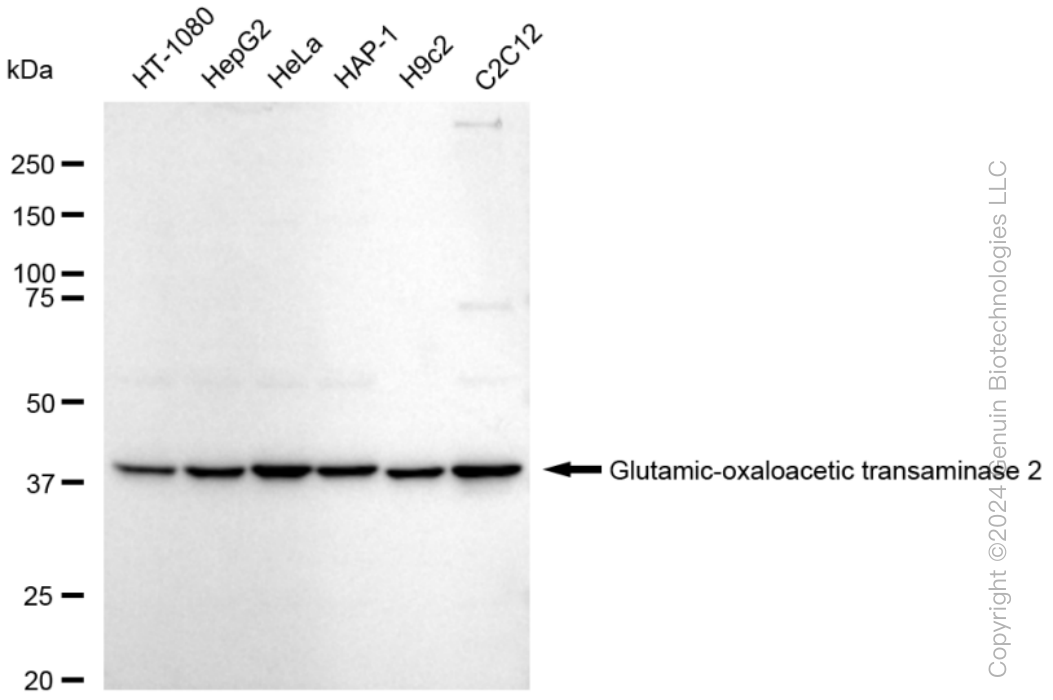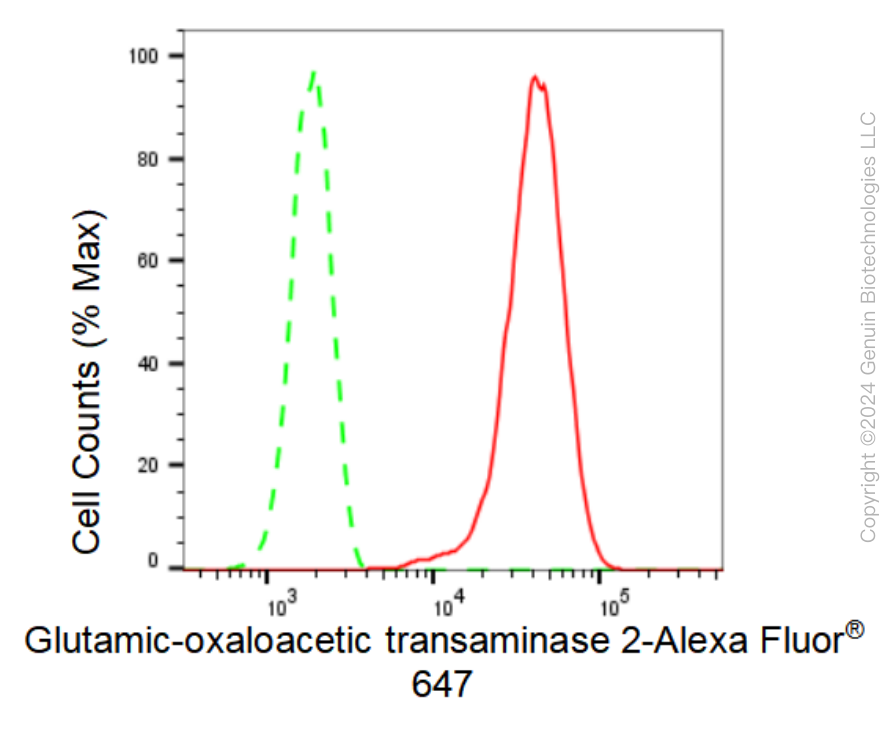KD-Validated Anti-Glutamic-oxaloacetic transaminase 2 Rabbit Monoclonal Antibody
Rabbit monoclonal antibody
- SPECIFICATION
- CITATIONS
- PROTOCOLS
- BACKGROUND

Application
| WB, FC |
|---|---|
| Primary Accession | P00505 |
| Reactivity | Rat, Human, Mouse |
| Clonality | Monoclonal |
| Isotype | Rabbit IgG |
| Clone Names | 23GB7985 |
| Calculated MW | Predicted, 48 kDa , observed , 43 kDa |
| Gene Name | GOT2 |
| Aliases | GOT2; Glutamic-Oxaloacetic Transaminase 2; KYAT4; Kynurenine Aminotransferase IV; MAspAT; KATIV; KAT4; Plasma Membrane-Associated Fatty Acid-Binding Protein; Glutamic-Oxaloacetic Transaminase 2, Mitochondrial; Aspartate Aminotransferase, Mitochondrial; Kynurenine--Oxoglutarate Transaminase IV; Kynurenine--Oxoglutarate Transaminase 4; Glutamate Oxaloacetate Transaminase 2; Kynurenine Aminotransferase 4; Aspartate Aminotransferase 2; Fatty Acid-Binding Protein; Aspartate Transaminase 2; Transaminase A; EC 2.6.1.1; MitAAT; FABP-1; FABPpm; Glutamic-Oxaloacetic Transaminase 2, Mitochondrial (Aspartate Aminotransferase 2); EC 2.6.1.7; EC 2.6.1; MITAAT; DEE82 |
| Immunogen | A synthesized peptide derived from human GOT2 |
| Gene ID | 2806 |
|---|---|
| Other Names | Aspartate aminotransferase, mitochondrial, mAspAT, 2.6.1.1, 2.6.1.7, Fatty acid-binding protein, FABP-1, Glutamate oxaloacetate transaminase 2, Kynurenine aminotransferase 4, Kynurenine aminotransferase IV, Kynurenine--oxoglutarate transaminase 4, Kynurenine--oxoglutarate transaminase IV, Plasma membrane-associated fatty acid-binding protein, FABPpm, Transaminase A, GOT2 (HGNC:4433) |
| Name | GOT2 (HGNC:4433) |
|---|---|
| Function | Catalyzes the irreversible transamination of the L-tryptophan metabolite L-kynurenine to form kynurenic acid (KA). As a member of the malate-aspartate shuttle, it has a key role in the intracellular NAD(H) redox balance. Is important for metabolite exchange between mitochondria and cytosol, and for amino acid metabolism. Facilitates cellular uptake of long-chain free fatty acids. |
| Cellular Location | Mitochondrion matrix. Cell membrane. Note=Exposure to alcohol promotes translocation to the cell membrane. |

Thousands of laboratories across the world have published research that depended on the performance of antibodies from Abcepta to advance their research. Check out links to articles that cite our products in major peer-reviewed journals, organized by research category.
info@abcepta.com, and receive a free "I Love Antibodies" mug.
Provided below are standard protocols that you may find useful for product applications.
If you have used an Abcepta product and would like to share how it has performed, please click on the "Submit Review" button and provide the requested information. Our staff will examine and post your review and contact you if needed.
If you have any additional inquiries please email technical services at tech@abcepta.com.














 Foundational characteristics of cancer include proliferation, angiogenesis, migration, evasion of apoptosis, and cellular immortality. Find key markers for these cellular processes and antibodies to detect them.
Foundational characteristics of cancer include proliferation, angiogenesis, migration, evasion of apoptosis, and cellular immortality. Find key markers for these cellular processes and antibodies to detect them. The SUMOplot™ Analysis Program predicts and scores sumoylation sites in your protein. SUMOylation is a post-translational modification involved in various cellular processes, such as nuclear-cytosolic transport, transcriptional regulation, apoptosis, protein stability, response to stress, and progression through the cell cycle.
The SUMOplot™ Analysis Program predicts and scores sumoylation sites in your protein. SUMOylation is a post-translational modification involved in various cellular processes, such as nuclear-cytosolic transport, transcriptional regulation, apoptosis, protein stability, response to stress, and progression through the cell cycle. The Autophagy Receptor Motif Plotter predicts and scores autophagy receptor binding sites in your protein. Identifying proteins connected to this pathway is critical to understanding the role of autophagy in physiological as well as pathological processes such as development, differentiation, neurodegenerative diseases, stress, infection, and cancer.
The Autophagy Receptor Motif Plotter predicts and scores autophagy receptor binding sites in your protein. Identifying proteins connected to this pathway is critical to understanding the role of autophagy in physiological as well as pathological processes such as development, differentiation, neurodegenerative diseases, stress, infection, and cancer.




